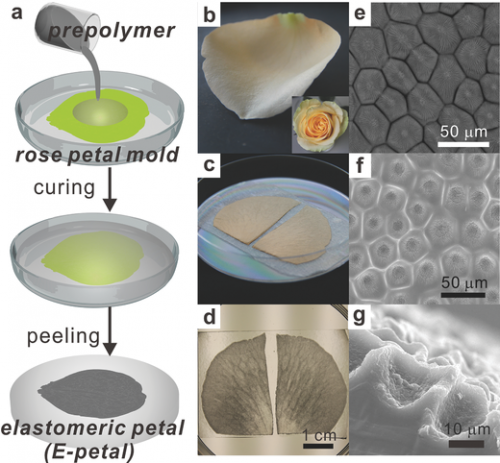March 8, 2015 weblog
Using E-petals for making stretchable metal conductors

The research beat goes on in stretchable electronics. Scientists work on solutions for ultraflexible, stretchable, and wearable electronics and pursue advanced materials toward that end. Dr. Peter Harrop, chairman of market research firm IDTechEx, has looked at the potential of stretchable electronics and defines the term as concerning electrical and electronic circuits and combinations of these "elastically or inelastically stretchable by more than a few percent while retaining function." Harrop authored the report, "Stretchable Electronics and Electrics 2015-2025: Technologies, Markets, Forecasts."
He said it was convenient to consider stretchable electronics as a part of printed electronics, "a term taken to include printed and potentially printed (eg thin film) electronics and electrics." Harrop said both end users and participants see huge potential. He said, "Electronics that are very elastic or deformable without loss of function has seen several hundred million dollars spent by universities on such research so far and more modest tens of millions of dollars has been raised by companies to pursue the opportunity...Others are involved in the materials to enable stretchable electronics such as carbon nanotubes."
New on the research scene is a report published online by Advanced Science. The report is on the development of E-petal, a new biomimicking elastomeric substrate, suitable for making a variety of stretchable conductors and devices. The paper, published online on February 9, is titled, "Biomimicking Topographic Elastomeric Petals (E-Petals) for Omnidirectional Stretchable and Printable Electronics," and the authors are from institutions in Hong Kong, Beijing, Shenzhen and Lanzhou.
The authors said that "E-petals can be readily used for making solution-processed stretchable metal conductors, which are critical and inevitable components in the future printable fabrication of highly flexible and stretchable electronics." They found that the easy fabrication of stretchable conductors on E-petal by solution-processed methods was "ideal for printable electronics applications."
What exactly is E-petal? The elastomeric petals are directly replicated from the natural rose petal as new and versatile substrates for stretchable and printable electronics. These have biomimicking topographic surfaces which can inhibit the propagation of microcracks formed in the conducting layer, which is deposited on top, regardless of the type of conductive materials and deposition methods. The E-petals are made by one-step soft lithographic replication using natural rose petals as molds.
Fresh petals of yellow roses were taped onto a plastic petri dish and used as the mold. A mixture of polydimethylsiloxane (PDMS) prepolymer and its curing agent in a ratio of 10:1 was poured on the rose petals. This was followed by degassing in a vacuum desiccator. Curing took place at room temperature; then the E-petals were obtained by peeling off the cured PDMS from the petal mold. The authors in their own words explained how the E-petals were prepared. "PDMS prepolymer and the curing agent were mixed in a ratio of 10:1 and the bubbles were removed by degassing in a vacuum desiccator. The mixture was poured onto the surface of rose petals, which were taped on a plastic petri dish. After being cured at room temperature for 48 h, textured PDMS was peeled off from rose petal. Then PDMS was treated by ultrasonication in NaOH aqueous solution (13 wt%), acetone, ethanol, and DI water in sequence. Finally, the biomimicking E-petal was formed after curing at 70 °C for 2 h in an oven."
The authors also discussed E-petal advantages. These can be used for making omnidirectional stretchable conductors without the need for prestretching of substrate or complicated serpentine design and patterning, which is required when using conventional flat PDMS substrates. The E-petal is suitable for roll-to-roll printable electronics because the patterning and materials deposition process does not require special handling, alignment or design. The E-petal is versatile for many kinds of conductive materials, such as metal and conducting polymer, regardless of their deposition methods. The authors said, "We believe that E-petals can replace flat PDMS substrates in many applications for making stretchable conductors and devices in the future."
More information: Biomimicking Topographic Elastomeric Petals (E-Petals) for Omnidirectional Stretchable and Printable Electronics, Article first published online: 9 FEB 2015. DOI: 10.1002/advs.201400021
Abstract
Elastomeric petals directly replicated from natural rose petal are new versatile substrates for stretchable and printable electronics. Compared with conventional flat polydimethylsiloxane substrates, elastomeric petals have biomimicking topographic surfaces that can effectively inhibit the propagation of microcracks formed in the conducting layer, which is deposited on top, regardless of the type of conductive materials and the deposition methods.
© 2015 Phys.org



















